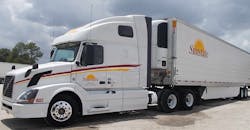Expecting upgrades: Planning for innovation in food transport
The food and beverage transportation industry is evolving rapidly, challenging fleets to upgrade their current systems to accommodate both new regulation and emerging technology. In recent years alone, fleets have been required to adapt to sweeping policy changes like the FDA Food Safety Modernization Act and the FMCSA Electronic Logging Device (ELD) mandate. Simultaneously, innovation in trucking technology, such as ADAS, remote cargo monitoring, telematics and video-based safety, are continually transforming how fleets and drivers conduct business.
These upgrades, along with the upcoming shift from a 3G to 4G cellular network, have forced managers to closely examine their existing technology stack and upgrade as necessary. In an industry where timeliness and efficiency determine success, foodservice and distribution fleets can’t afford to partner with a provider that locks them into a solution today that won’t necessarily meet their needs tomorrow. Decision-makers must prepare for the next wave of industry transformation by understanding how their fleet’s technology will work in the future.
Convergence Is Key
The impending sunset of 3G and mandatory migration to 4G LTE is a catalyst for technological transformation in the industry, offering individual fleets a chance to reshape their approach to technology. While upgrades ultimately improve the bottom line, adopting new technology is challenging, requiring extensive hardware installation and seemingly never-ending training. According to a survey from TD Bank, 50% of fleet managers report concern about keeping up with the latest technology—more than half of respondents said changing technology poses the biggest challenge in the coming year.
With an abundance of options available, it’s all too easy to choose a quick-fix solution that only responds to a fleet’s immediate needs. It’s in these moments that fleet managers must consider a configurable program with hardware flexibility, as well as knowledgeable customer service and support when assessing providers. By investing in solutions capable of data convergence, fleets can adopt a streamlined approach to managing all their technology assets—video-based safety, advanced analytics, telematics and ELD compliance—from a single onboard data collection hub. Beyond offering an integrated view of driving performance analytics, convergence ensures fleets remove extraneous hardware, sync data from multiple sources, eliminate data redundancy and reduce costs associated with installation and maintenance.
Managing Data and Drivers? The Benefits of a Managed Service
Few fleets have the internal resources to review the massive amounts of data produced by today’s technology solutions, let alone efficiently analyze the information to identify risk and opportunity. A managed service eliminates this tedious overhead by providing a consistent, unbiased and professional system to review, score and prioritize thousands of videos. These programs can be customized to score events based on the fleet’s safety and compliance priorities; fleets now have access to round-the-clock coverage in case an incident occurs at night, on the weekend or on a holiday. Additionally, expert analysis and a unified view of risk and driver performance is scalable as a standardized, repeatable process that derives consistently meaningful insights and delivers substantial results.
A managed service program also ensures both fleet managers and drivers adapt seamlessly to the new technology, beginning with rollout and throughout the entirety of the partnership. The insights allow fleet managers to quickly identify which drivers are more likely to be involved in an incident and allocate time for coaching appropriately. When coupled with monetary and non-monetary recognition, accurately measuring drivers’ performance can also serve as the foundation of successful recognition and reward programs. Besides incentives, drivers can leverage performance insight to improve their own driving skills and demonstrate their value to management when negotiating a promotion.
Despite Challenges, New Technology is Good for Business
When working with the right provider, new applications for today’s technology help fleets lower operating costs, eliminate risky driving behaviors, collect actionable data, exonerate drivers and keep employees safe. These technological tools are explicitly designed to improve all aspects of the transportation business and can have a profound impact on daily operations, annual expenses and company culture.
Video-based safety is proven to strengthen trust with both the customer and the community by improving driving skills and reducing instances of collisions. By leveraging video-based safety, innocent drivers can be exonerated when accused of inciting a collision and curbing legal costs. These outcomes can be used in securing buy-in for employees. Outside of improving driving performance and overall fleet safety, video-based safety has proven itself helpful by identifying culprits when a theft occurs. The food and beverage industry has been historically prone to theft, particularly when it comes to wine, beer and spirits—according to a recent report from BSI Supply Chain Services and Solutions, food and beverages accounted for 34% of cargo theft in 2018. Overall, by reducing the risk of collisions and theft, video-based safety naturally helps fleets build customer loyalty and protects brand reputation.
Alongside video-safety technology, ELDs also received initial pushback from drivers. However, under the right management, ELDs ensure driver well-being is respected by accurately tracking hours of service to curb fatigue or burnout. A worthwhile ELD system also streamlines the tedious documentation process and cuts time required for inspections, effectively translating to more miles on the road. When coupled with a mobile app, today’s transportation intelligence offers drivers and fleet managers unprecedented insight into driving performance at the tip of their fingers, allowing them to monitor their safety scores and track their improvements.
Jason Palmer is the COO of SmartDrive Systems, a leading provider of video-based safety and transportation intelligence. As an expert in fleet safety and risk mitigation, Jason helps fleets in a variety of industries, including foodservice and distribution, identify and eliminate the riskiest driving behaviors that lead to collisions.
About the Author
Jason Palmer
Chief operating officer
Jason Palmer is the COO of SmartDrive Systems, a leading provider of video-based safety and transportation intelligence. As an expert in fleet safety and risk mitigation, Jason helps fleets in a variety of industries, including foodservice and distribution, identify and eliminate the riskiest driving behaviors that lead to collisions.
